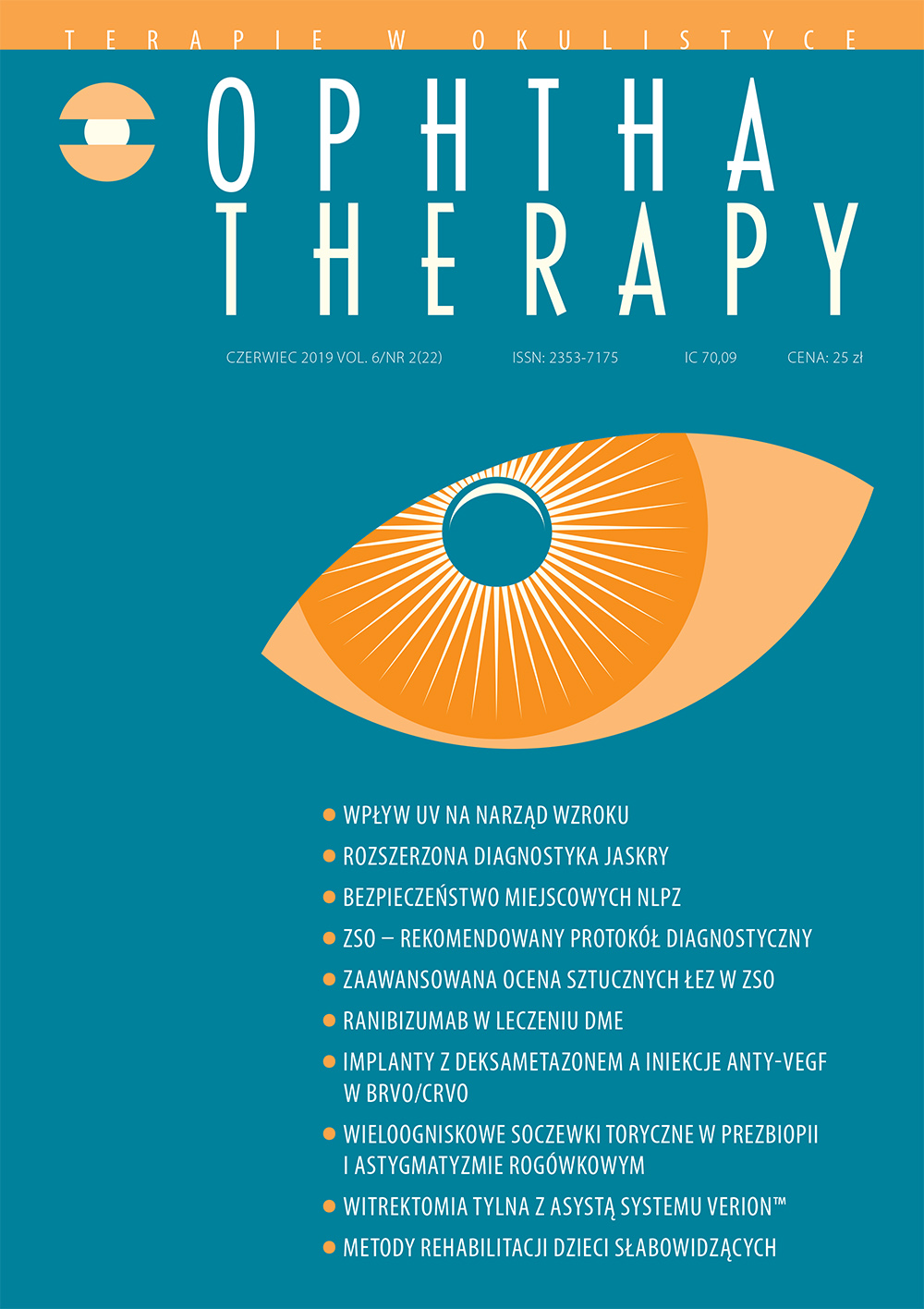Application of intraocular multifocal toric lenses in the correction of presbyopia and corneal astigmatism in cataract surgery – analysis of the refraction outcome and axial stability of the AcrySof IQ PanOptix TFNTx Intraocular Lens
Main Article Content
Abstract
Purpose: To evaluate distance, near and intermediate visual acuity, objective refraction, corneal keratometry and rotational stability after cataract surgery with an implantation of multifocal toric AcrySof® IQ PanOptix TFNTx intraocular lens in one-year follow-up.
Material and methods: A total of 20 eyes of 14 patients underwent 2.2 mm coaxial cataract surgery with an implantation of AcrySof® IQ PanOptix TFNTx intraocular lens. Before surgery uncorrected and best-corrected distance visual acuity, objective refraction and corneal keratometry were evaluated. Twelve months after the surgery uncorrected and best-corrected distance visual acuity, uncorrected near and intermediate visual acuity, objective refraction, corneal keratometry and rotational stability of the implant were analyzed.
Results: One year after the surgery there was statistically significant improvement of uncorrected and best-corrected distance visual acuity (p = 0.005 and p = 0.016). There was no significant change in corneal keratometry in flat and steep meridian (p = 0.94 and p = 0.63) and keratometric cylinder (p = 0.49). There was statistically significant decrease in objective refraction cylinder (p = 0.002). The mean rotation of an implanted intraocular lens axis was 2.51°. There were no intra- and post-operative complications in any of the patients.
Conclusions: AcrySof® IQ PanOptix TFNTx intraocular lens implantation is a safe and effective method to correct presbyopia coexisting with corneal astigmatism during cataract surgery.
Downloads
Article Details

This work is licensed under a Creative Commons Attribution-NonCommercial-NoDerivatives 4.0 International License.
Copyright: © Medical Education sp. z o.o. License allowing third parties to copy and redistribute the material in any medium or format and to remix, transform, and build upon the material, provided the original work is properly cited and states its license.
Address reprint requests to: Medical Education, Marcin Kuźma (marcin.kuzma@mededu.pl)
References
2. Lehmann R, Waycaster C, Hileman K. A comparison of patient-reported outcomes from an apodized diffractive intraocular lens and a conventional monofocal intraocular lens. Curr Med Res Opin. 2006; 22(12): 2591-602.
3. Hayashi K, Manabe S, Yoshida M et al. Effect of astigmatism on visual acuity in eyes with a diffractive multifocal intraocular lens. J Cataract Refract Surg. 2010; 36(8): 1323-9.
4. Ferrer-Blasco T, Montés-Micó R, Peixoto-de-Matos SC et al. Prevalence of corneal astigmatism before cataract surgery. J Cataract Refract Surg. 2009; 35(1): 70-5.
5. Sachdev GS, Sachdev M. Optimizing outcomes with multifocal intraocular lenses. Indian J Ophthalmol. 2017; 65(12): 1294.
6. Gundersen KG, Makari S, Ostenstad S, Potvin R. Retreatments after multifocal intraocular lens implantation: an analysis. Clin Ophthalmol Auckl NZ. 2016; 10: 365-71.
7. Kohnen T, Herzog M, Hemkeppler E et al. Visual Performance of a Quadrifocal (Trifocal) Intraocular Lens Following Removal of the Crystalline Lens. Am J Ophthalmol. 2017; 184: 52-62.
8. de Carneros-Llorente AM, de Carneros AM, de Carneros-Llorente PM et al. Comparison of visual quality and subjective outcomes among three trifocal intraocular lenses and one bifocal intraocular lens. J Cataract Refract Surg. 2019; 45(5):587-94.
9. García-Pérez JL, Gros-Otero J, Sánchez-Ramos C et al. Short term visual outcomes of a new trifocal intraocular lens. BMC Ophthalmol. 2017; 17: 72. https://doi.org/10.1186/s12886-017-0462-y.
10. Lehmann R, Modi S, Fisher B et al. Bilateral implantation of +3.0 D multifocal toric intraocular lenses: results of a US Food and Drug Administration clinical trial. Clin Ophthalmol Auckl NZ. 2017; 11: 1321-31.
11. Knorz MC, Rincón JL, Suarez E et al. Subjective Outcomes After Bilateral Implantation of an Apodized Diffractive +3.0 D Multifocal Toric IOL in a Prospective Clinical Study. J Refract Surg. 2013; 29(11): 762-7.
12. Kohnen T, Nuijts R, Levy P et al. Visual function after bilateral implantation of apodized diffractive aspheric multifocal intraocular lenses with a +3.0 D addition. J Cataract Refract Surg. 2009; 35(12): 2062-9.
13. Lane SS, Javitt JC, Nethery DA, Waycaster C. Improvements in patient-reported outcomes and visual acuity after bilateral implantation of multifocal intraocular lenses with +3.0 diopter addition: Multicenter clinical trial. J Cataract Refract Surg. 2010; 36(11): 1887-96.
14. Cochener B, Boutillier G, Lamard M, Auberger-Zagnoli C. A Comparative Evaluation of a New Generation of Diffractive Trifocal and Extended Depth of Focus Intraocular Lenses. J Refract Surg. 2018; 34(8): 507-14.

